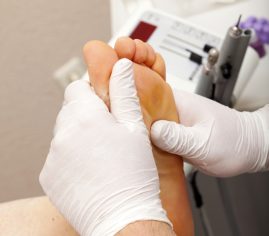Metatarsalgia
Metatarsalgia is a term that describes pain in the metatarsal area of the forefoot, the ball of the foot, that can feel worse when walking or running. There may be a burning or aching sensation in the ball of the foot and some people compare the sensation to ‘walking on pebbles’. The intensity of the pain varies from mild to severe. Shooting pains in the toes, tingling or numbness around the toes, and worsening pain when standing or moving are all common symptoms of metatarsalgia. Symptoms usually develop gradually over a period of months.
Abnormal pressure loading can be a common cause of pain in this area which can be due to poorly fitting footwear, such as narrow, high heeled shoes which force the foot into a small space, can cause the condition. Certain foot shapes are more likely to suffer with metatarsalgia, for example, a narrow, high arched foot where pressure is great on the front part of the foot. Athletes who take part in high-impact sports which involve running or jumping have an increases risk of developing forefoot problems. Being overweight also increases pressure on the foot. As we age the protective ‘fat pad’ that sits over our metatarsal heads for protection begins to displace and thin, leaving the bones more exposed to pressure. Metatarsalgia is often associated and is a symptom of; hammer toes, Mortons’ neuroma and osteoarthritis of the feet. Continued high pressure on the forefoot may lead to stress fractures of the metatarsals.
Podiatry treatment – Podiatry treatment and advice will depend on the symptoms. Reducing the levels of pressure over the area is key and rest from certain activities may be necessary. Treatment can include a biomechanical assessment and orthotics issue which will improve the function of the foot and redistribute pressure to protect the ball of the foot. Cushioning insoles may also provide relief as will appropriate footwear for shock absorbtion.
Mortons Neuroma
Morton’s neuroma is a condition that affects one of the nerves between the toes. It is also known as Morton’s metatarsalgia or interdigital neuroma. It most commonly affects the nerve between the 3rd and 4th toe. Fibrous tissue develops around the nerve, which becomes irritated and compressed. This causes severe pain on the ball of the foot and at the base of the toes.
A number of other foot problems, including flat feet,high foot arches, bunions and hammer toes, as well as tight footwear may play a role in Morton’s neuroma because these conditions may cause the metatarsal bones to rub against the nerve.
Podiatry treatment – Treatment for Morton’s neuroma will depend on how long you’ve had the condition and its severity. Simple non-surgical treatments can be effective for some people but others may need surgery.
If diagnosed early, treatment will aim to reduce the pressure on the affected nerve. Simple measures such as rest, ice packs, changing footwear or using orthotic devices may help ease the pressure on the nerve. The next stage would be to use injections to numb the nerve which can be very effective. Surgery for Morton’s neuroma is now usually a treatment of last resort and is only recommended if you have severe pain in your foot or if non-surgical treatments haven’t worked.

